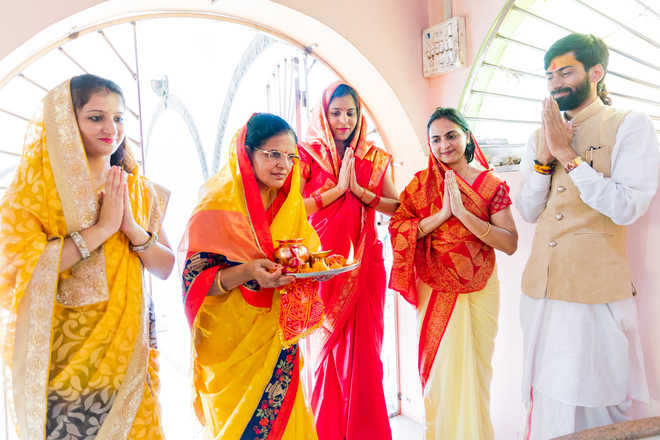Dr Satish K Kapoor
Ahoi (Hoi) Mata is a benign form of Shakti, equated with mother goddesses like Brahmani, Rudrani and Kamala. She is propitiated by a vast majority of Hindu mothers, mostly in north India, on Kartika Krishna Ashtami, the 8th day in the dark fortnight of the Hindu lunar month, Kartika. As a part of the primal force of life, she inspires faith, grants boons, and ensures protection to the devout.
Vrata and women
A vrata is meant to purify the body, the mind and the soul through self-discipline and moral restraints. It generates psychic powers, conducive to spiritual growth and the fulfillment of worldly desires. Hindu women observe a number of vrata-s for their own welfare or that of their kin – Vata savitri, Haritalika and Karvachautha for wedded bliss; Bhratri panchami and Bhratri dvitiya, for the protection of brothers; Mahalakshmi vrata for prosperity and safety; Sankashtha chaturthi, for avoiding any future calamity, and Navaratra-s for divine grace. Among the long list of vrata-s, Ahoi ashtami (also called Ahoi athe) is solemnized for the wellbeing of children, and for a happy family life. Married women who are childless or who do not have a male child, also worship her.
Origin of Ahoi ashtami
The most popular story about Ahoi ashtami vrata is that of a mother of seven sons who accidentally caused the death of the little ones of sehi (syahu), an animal with sharp spikes on its back, while digging the soil with a spade for the repair of her house. Within a year her children died one by one. To atone for her sin of killing, she observed a fast on Ahoi ashtami, as advised by senior women, with the result that she was blessed with sons again.
Procedure of fasting
On this day, mothers get up before sunrise, take bath, and observe complete fast during the day, without drinking even water. They are expected to avoid talking too much or speaking ill of others. The fast is opened at the end of the day, after offering arghya, oblation, to a star, and worshipping the goddess Ahoi.
Mode of worship
Images of the goddess, and that of sehi and its offsprings, are drawn up on a wall (using geru, red ochre) in the north-eastern part of the house, and enshrined as per procedure. As an alternative, a calendar, wall paper, or a piece of cloth, carrying a picture of the goddess, in an octagonal shape, is used. In front of the goddess is placed an unused earthen pot filled with water, or mangala kalasha, a copper vessel topped by coconut and mango leaves. Sometime, kalasha is established on the grains of wheat. Mauli, red thread, considered auspicious, is tied round the water-container, and rolled-up shoots of grass kept nearby for ceremonial purpose.
The goddess is offered gandha (perfume), pushpa (flowers), dhupa (incense), dipa (light) and naivedya (food) as a part of invocation rites. Items for sanctification include sugarcane, petha (ash gourd), radish, and cooked stuff like poori- halwa, boiled gram, gulgule (made of wheat flour and jaggery), kheer (made of milk, rice and sugar), etc. Ahoi- mantra, om ahoi devyai namah- is recited a few times, and the story of vrata listened to from an elderly woman. Names of family members are written on the wall or the poster of the goddess installed for worship. Finally, prayer is made, seeking blessings of the goddess, and sanctified food distributed.
Ahoi ashtami vrata reveals the intense concern of mothers for their children, showing why scriptures regard the mother as a living god. Says Devi Mahatmaya ( XI.5): striyah samastah sakala jagatsu – ‘all women are but His forms.’
(Dr Kapoor is a noted educationist, historian and spiritualist)
Unlock Exclusive Insights with The Tribune Premium
Take your experience further with Premium access.
Thought-provoking Opinions, Expert Analysis, In-depth Insights and other Member Only Benefits
Already a Member? Sign In Now










